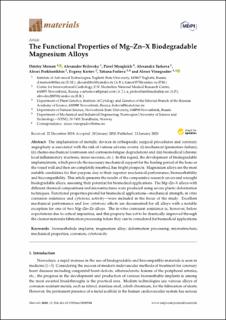| dc.description.abstract | The implantation of metallic devices in orthopaedic surgical procedures and coronary angioplasty is associated with the risk of various adverse events: (i) mechanical (premature failure), (ii) chemo-mechanical (corrosion and corrosion-fatigue degradation) and (iii) biomedical (chronic local inflammatory reactions, tissue necrosis, etc.). In this regard, the development of biodegradable implants/stents, which provide the necessary mechanical support for the healing period of the bone or the vessel wall and then are completely resorbed, has bright prospects. Magnesium alloys are the most suitable candidates for that purpose due to their superior mechanical performance, bioresorbability and biocompatibility. This article presents the results of the comparative research on several wrought biodegradable alloys, assessing their potential for biomedical applications. The Mg–Zn–X alloys with different chemical compositions and microstructures were produced using severe plastic deformation techniques. Functional properties pivotal for biomedical applications—mechanical strength, in vitro corrosion resistance and cytotoxic activity—were included in the focus of the study. Excellent mechanical performance and low cytotoxic effects are documented for all alloys with a notable exception for one of two Mg–Zn–Zr alloys. The in vitro corrosion resistance is, however, below expectations due to critical impurities, and this property has yet to be drastically improved through the cleaner materials fabrication processing before they can be considered for biomedical applications | en_US |

